Bird in amber for sale in auction
Full details and images of the Red Bird In Amber that is up for auction on 23 November 2021 at Summers Place Auctions
Description of each image is below each image or on mouseover, all images are of the same Red Bird but from different angles or in different lighting and if you examine the entire series, it will help you understand how by varying the lighting we can choose whether we see feathers or skin or bones or a specific combination thereof.
Bid now at Summers Place Auctions websiteBid now at Drouot website
Bid at The Saleroom website
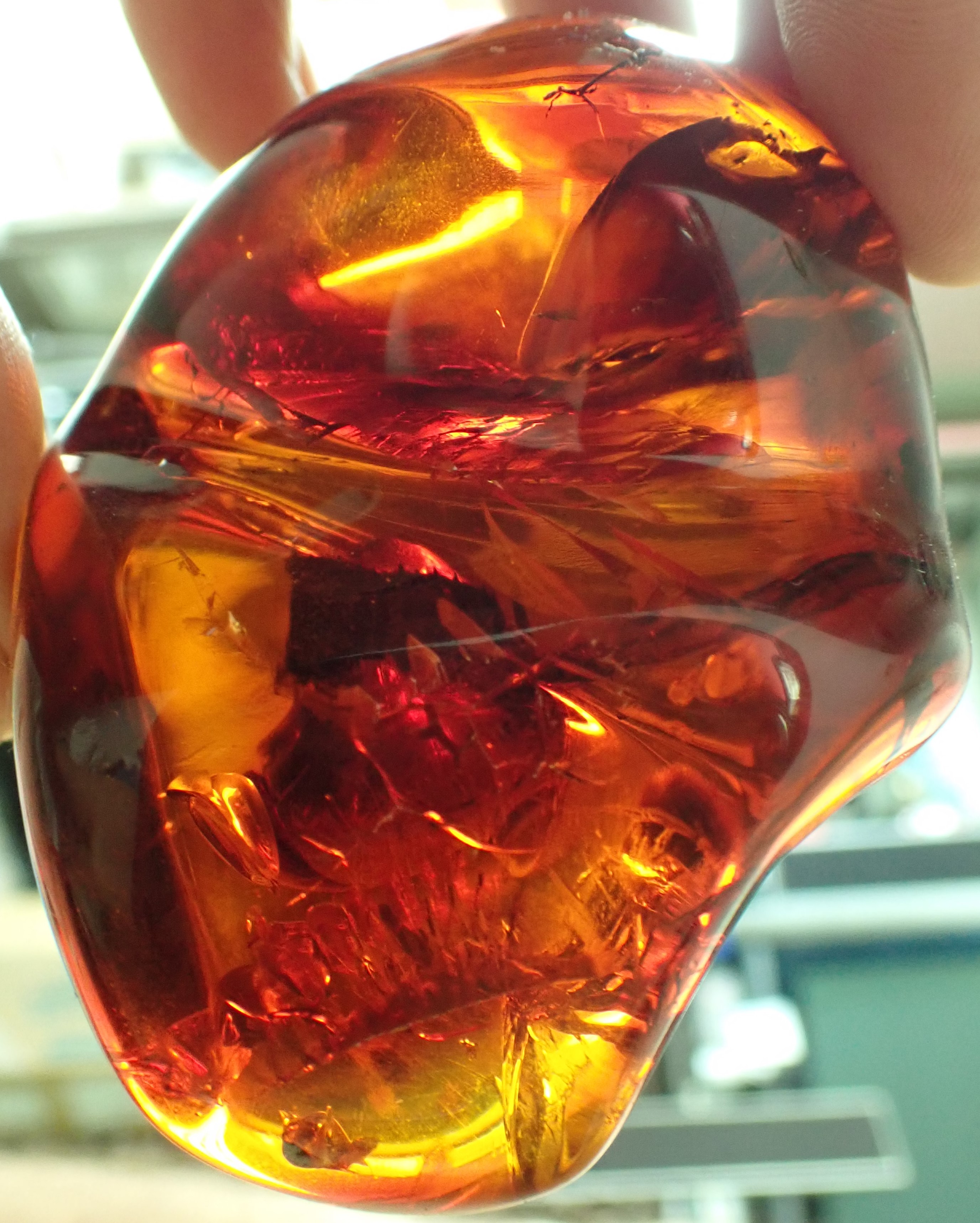
In the picture above the head is at the top left and the toes can be seen bottom right, this is a very popular photo as it clearly shows the hips of the bird and other bones, also clearly seen are the cute 4 pink toes on the rear leg. This picture shows that the amber itself is a golden yellow color whilst the protofeathers are a metallic red color.
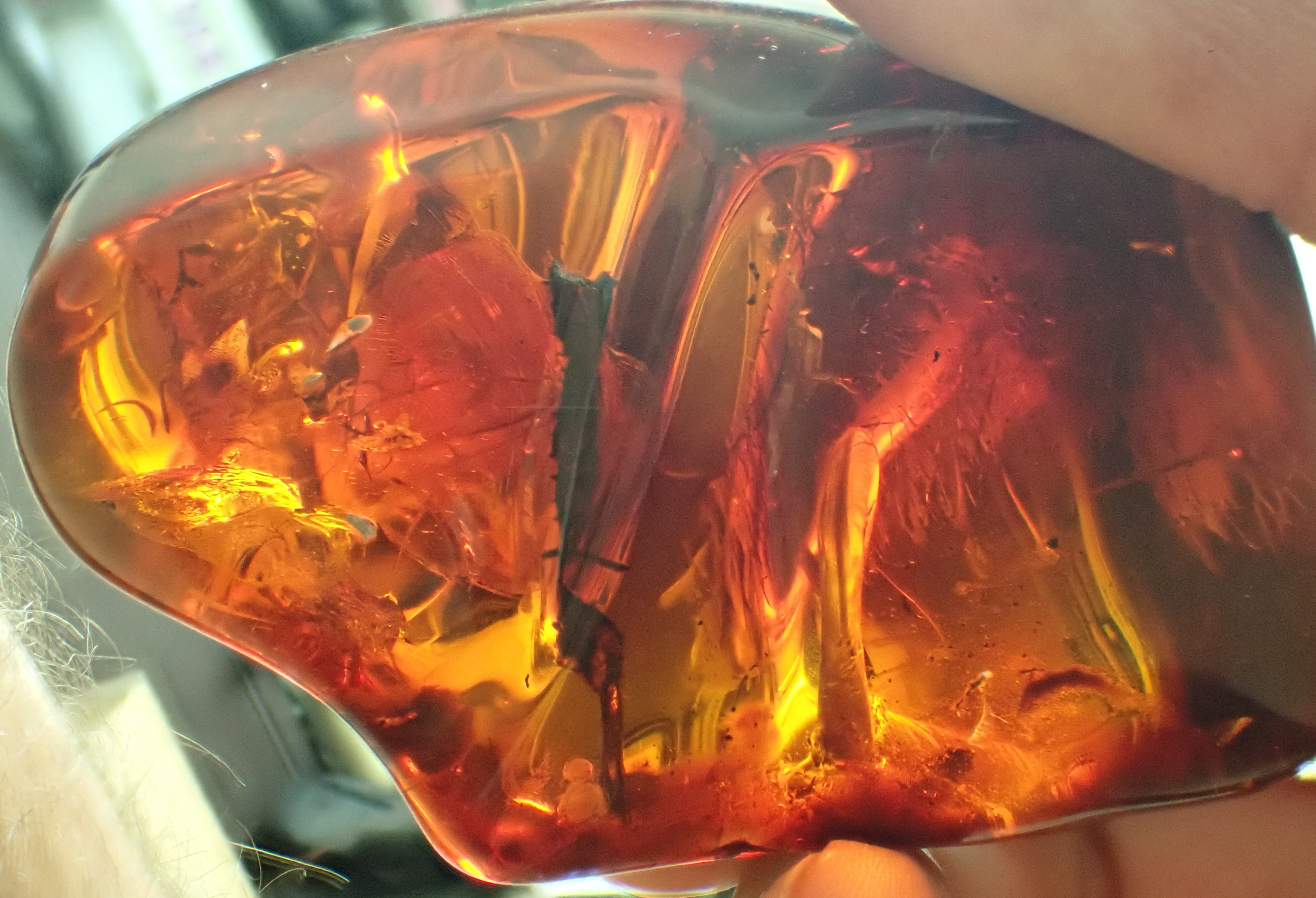
This horizontal view has the head to the left and tail to the far right, in the first image the tailbone is seen whereas in this image the fluffy feathery integument on the tail is seen. Interesting to note that the ribs of the smaller animal lying on the ground between the legs of this red bird can be clearly seen at the bottom of the amber.
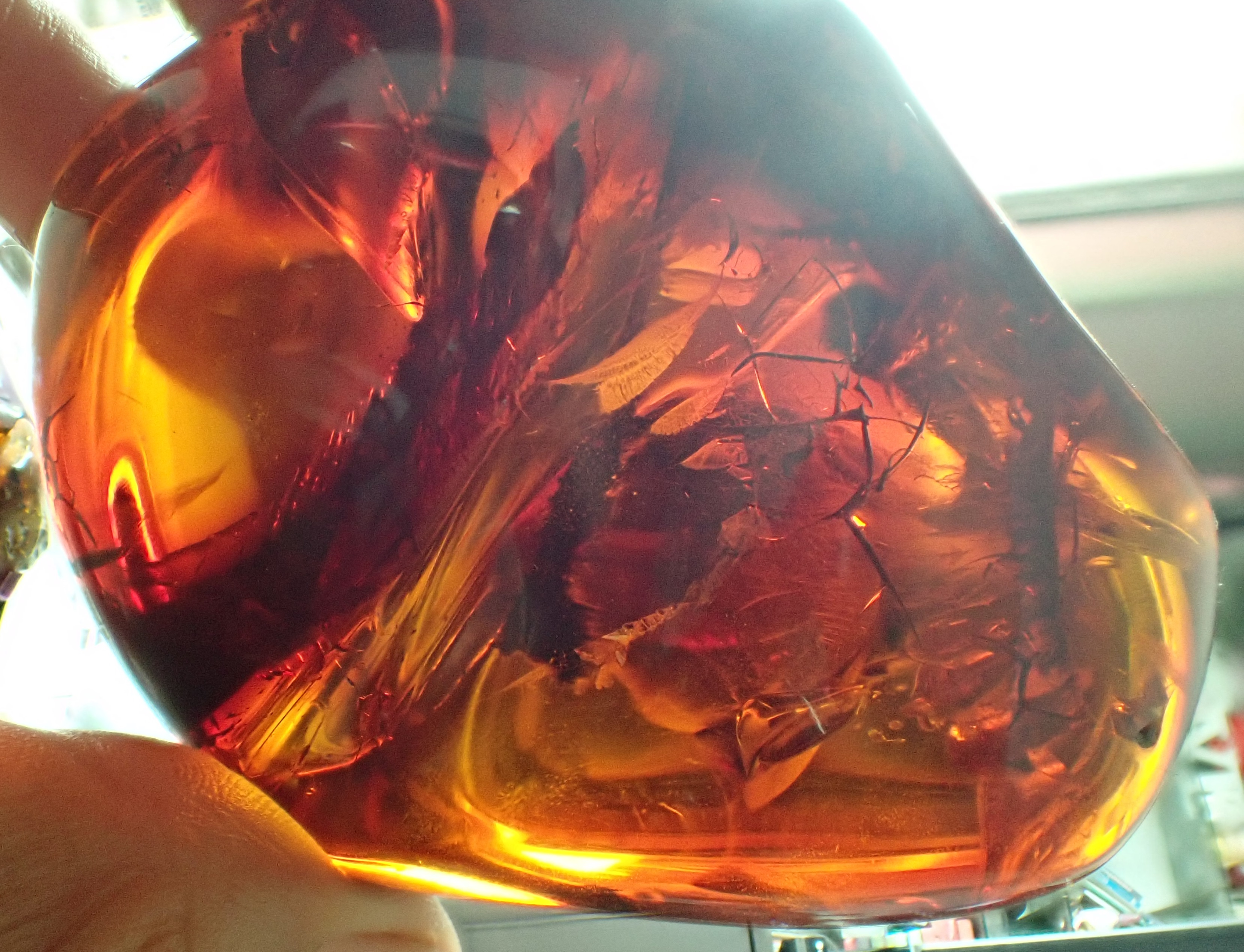
In the image above we can see the teeth on the beak of the bird and the shafts of the feathers along its front wings. There are long feathers on the rear legs too.
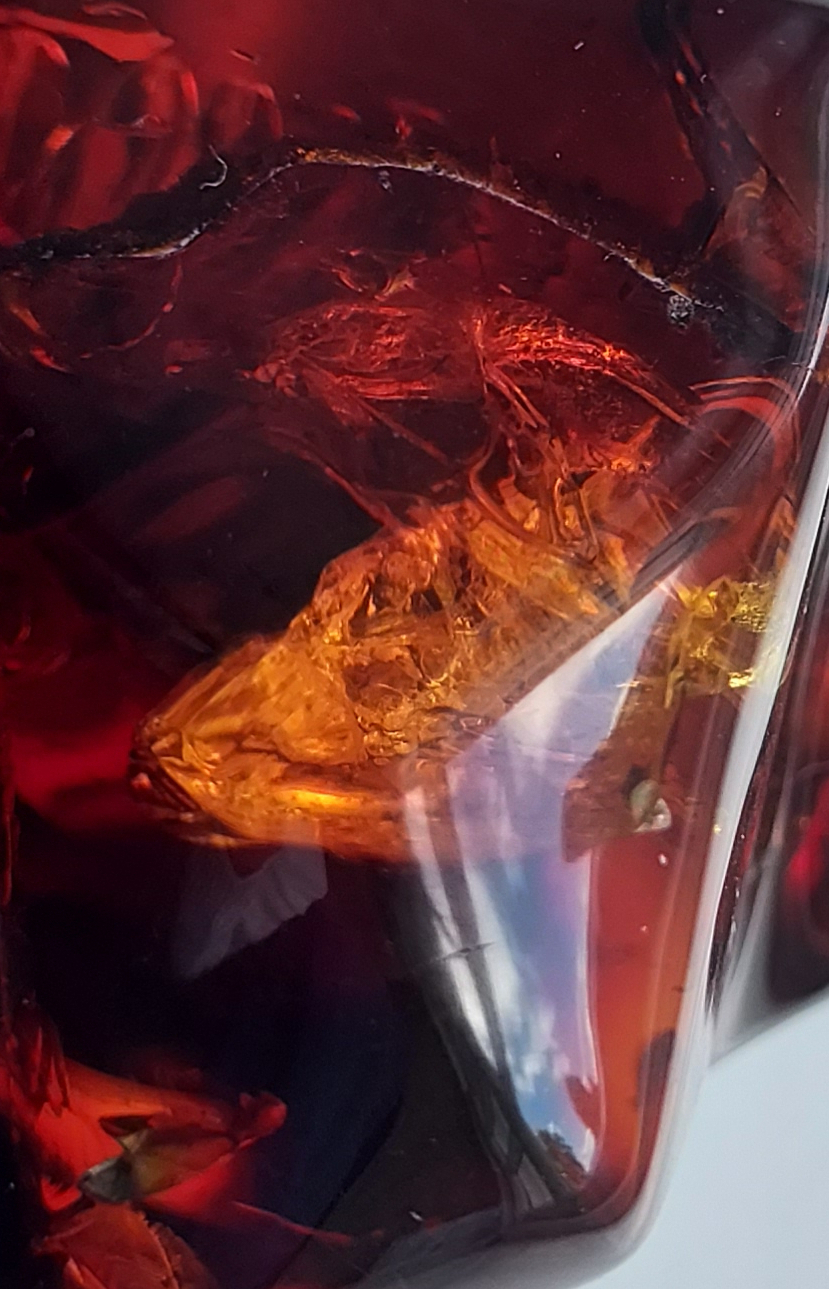
In this view of the head of the bird we can clearly see the teeth and bones in the skull as well as the ocular where the eyeball once resided.
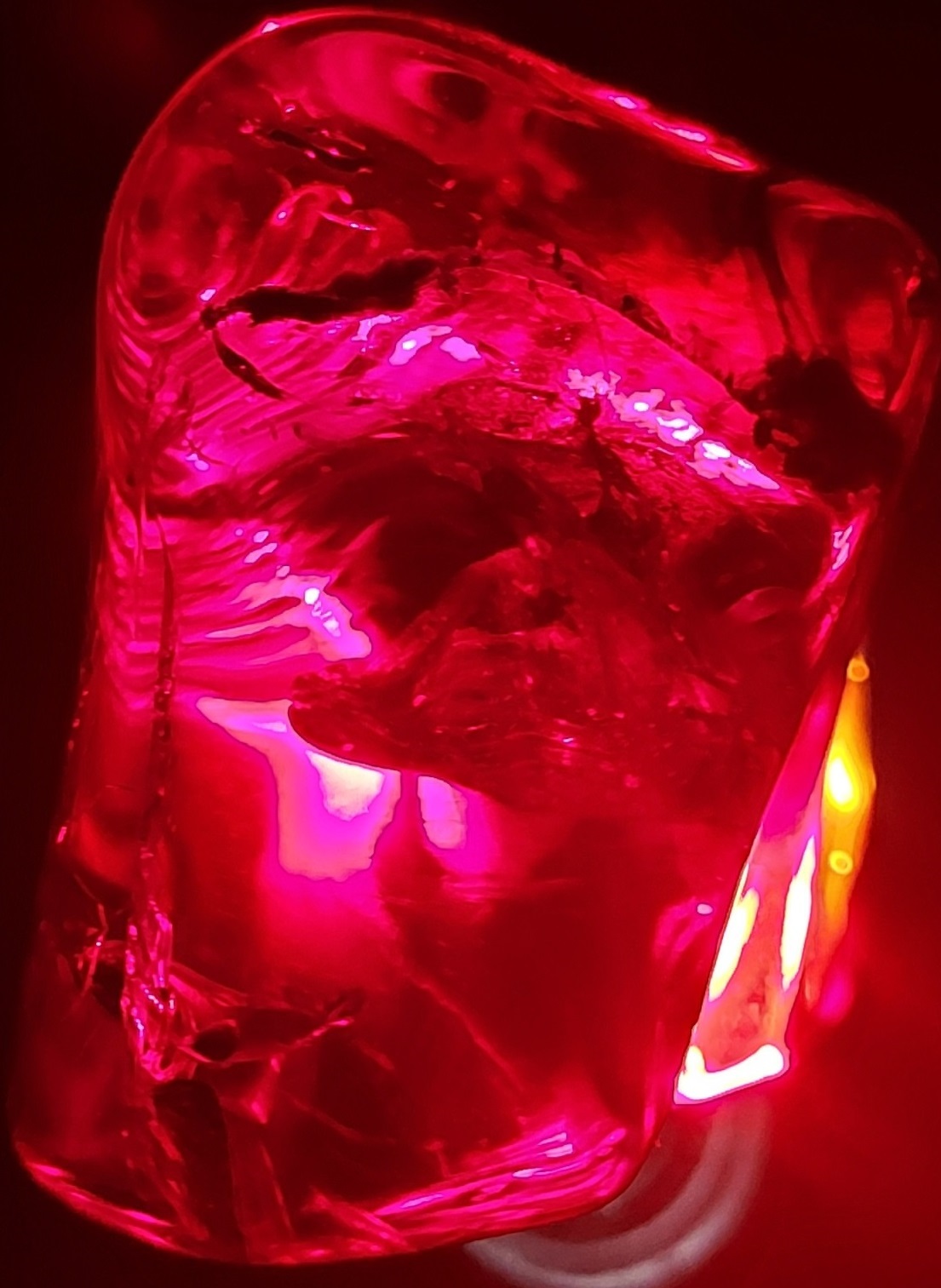
Backlit in darkness the entire piece lights up a neon pink color. Different lighting enables us to examine different layers of the bird easily.
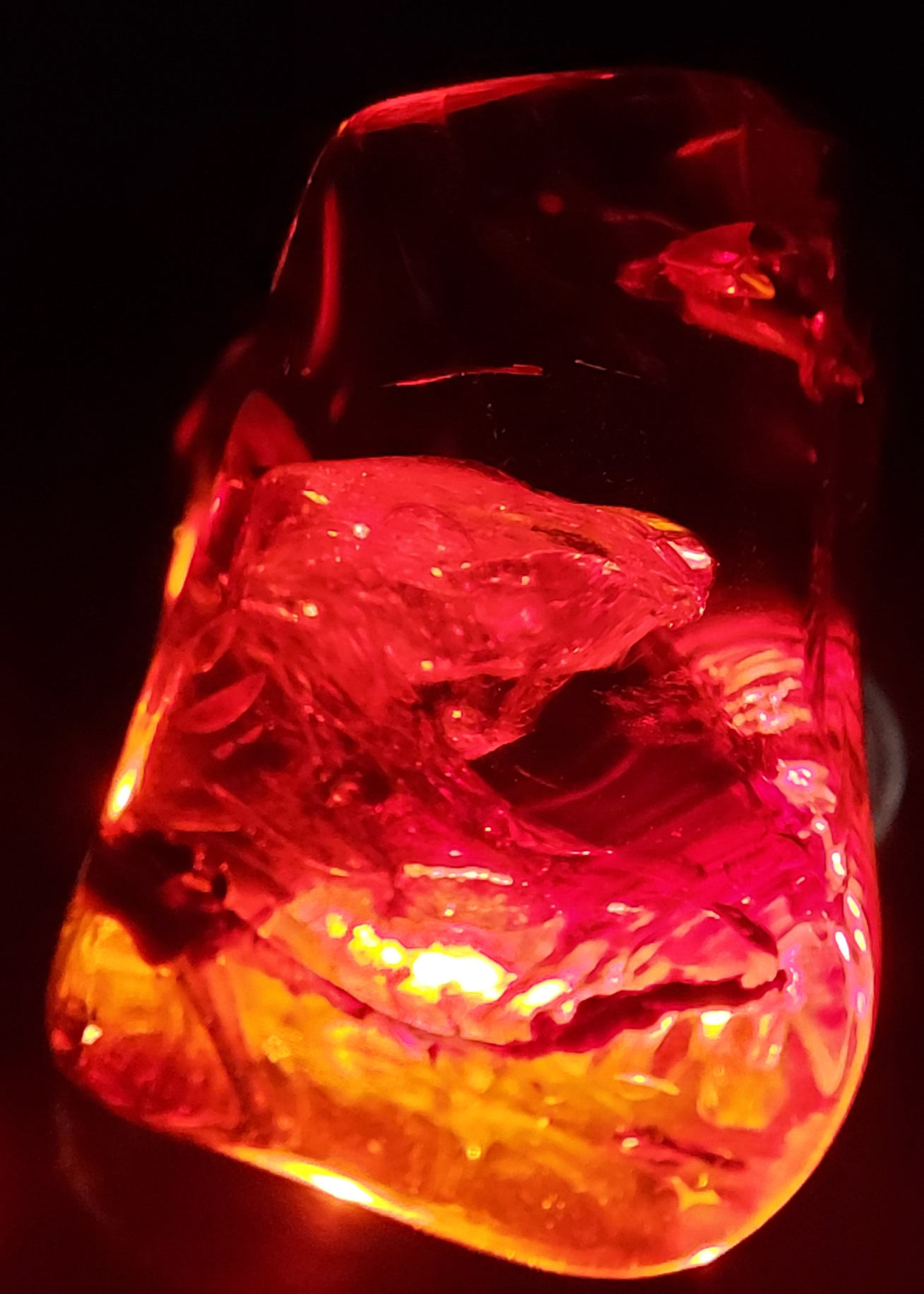
Under warm light the bird fluoreces a pink color, if you look carefully you can see the eyeball is still attached to the optic nerve.
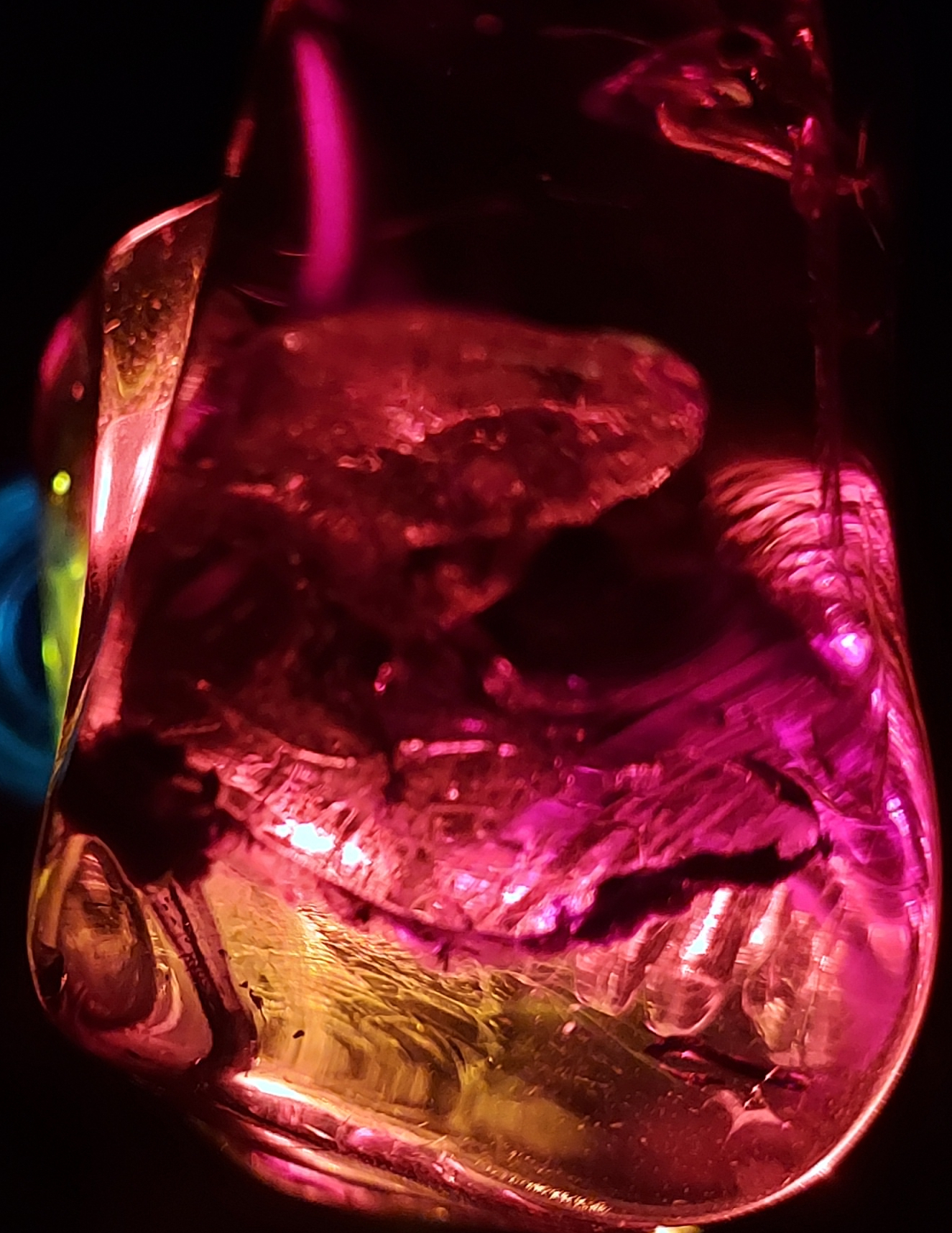
Under white light the bird in amber fluoresces a purple color.
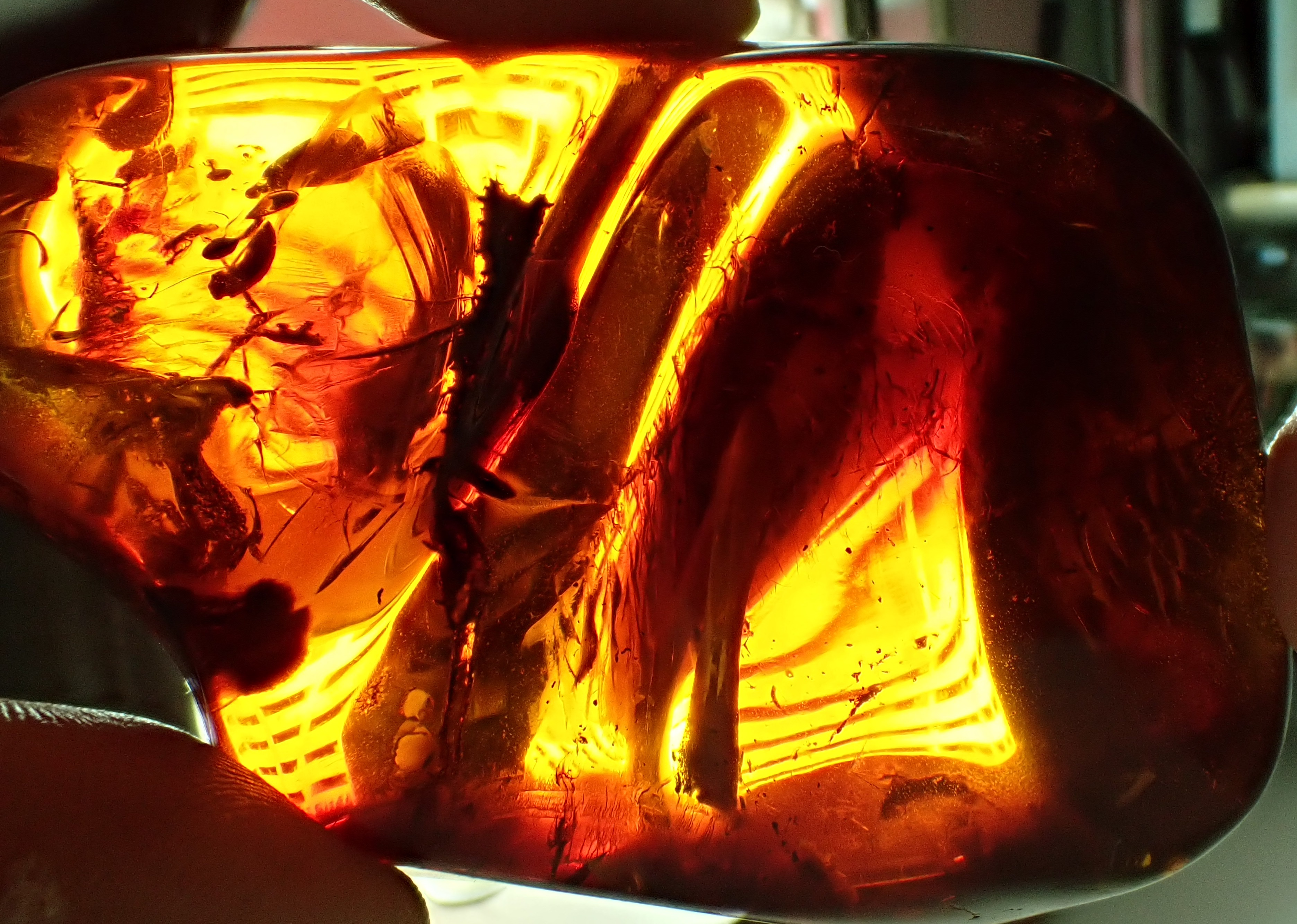
Changing the strength and angle of light reveals different aspects and in this image we see interesting tail and long lanky leg details.
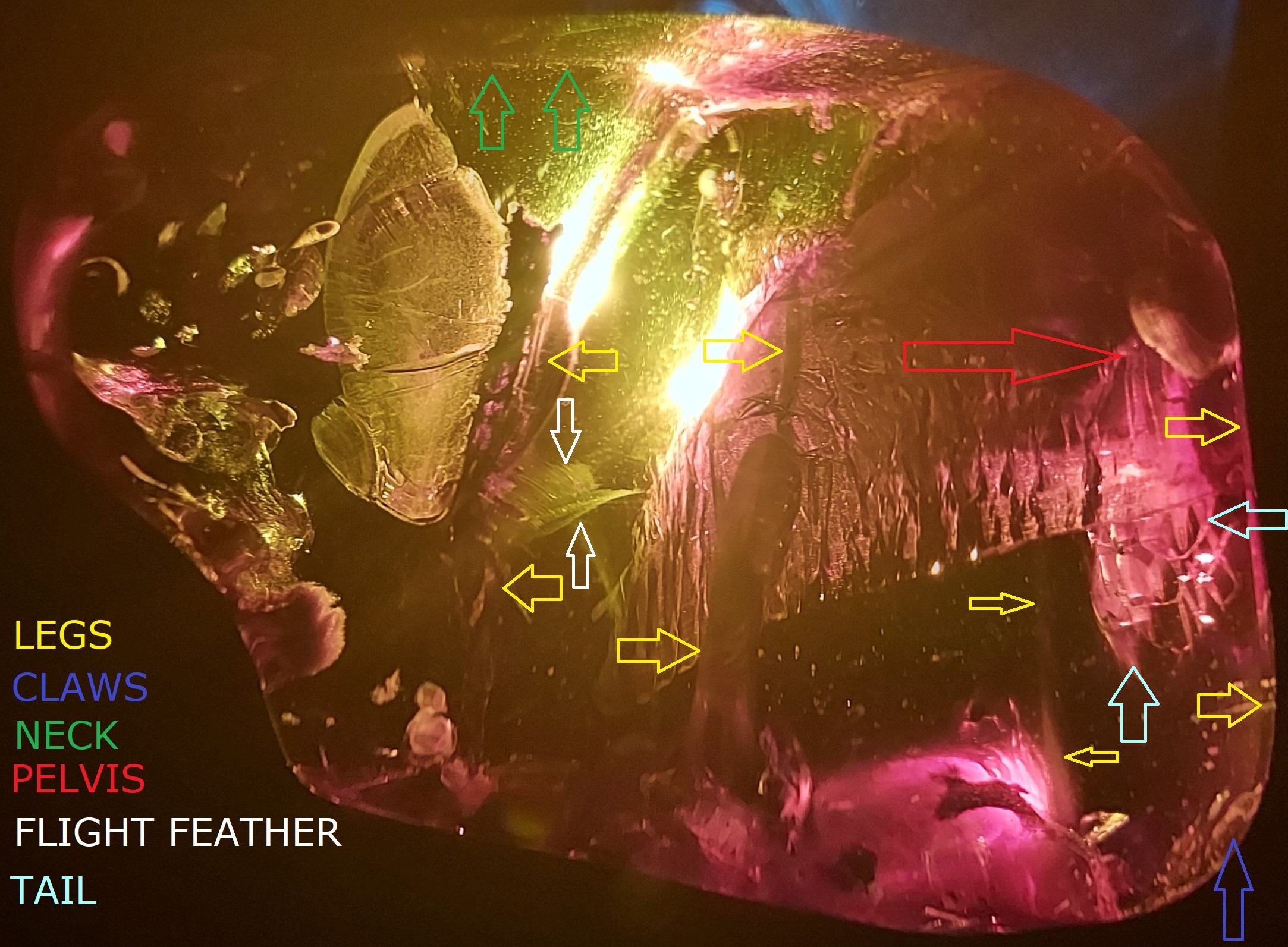
Labelled image of backlit amber showing legs tail feathers claws etc, this can be used also as a reference image when looking at the other images, it shows how certain lighting shows skin and feathers more whilst other lighting setups show more bones. The smaller bird that lays on the hollow floor between the main bird's legs can be seen very clearly in this image from head to tail. All four long legs are clearly labelled here as is the neck, you can compare this anatomy on the pictures that are fully illuminated adding the red feathers to the legs. As you consider this image set you will see that there are indeed flight feathers on both the front and rear legs unlike modern birds that only have flight feathers on their front limbs.
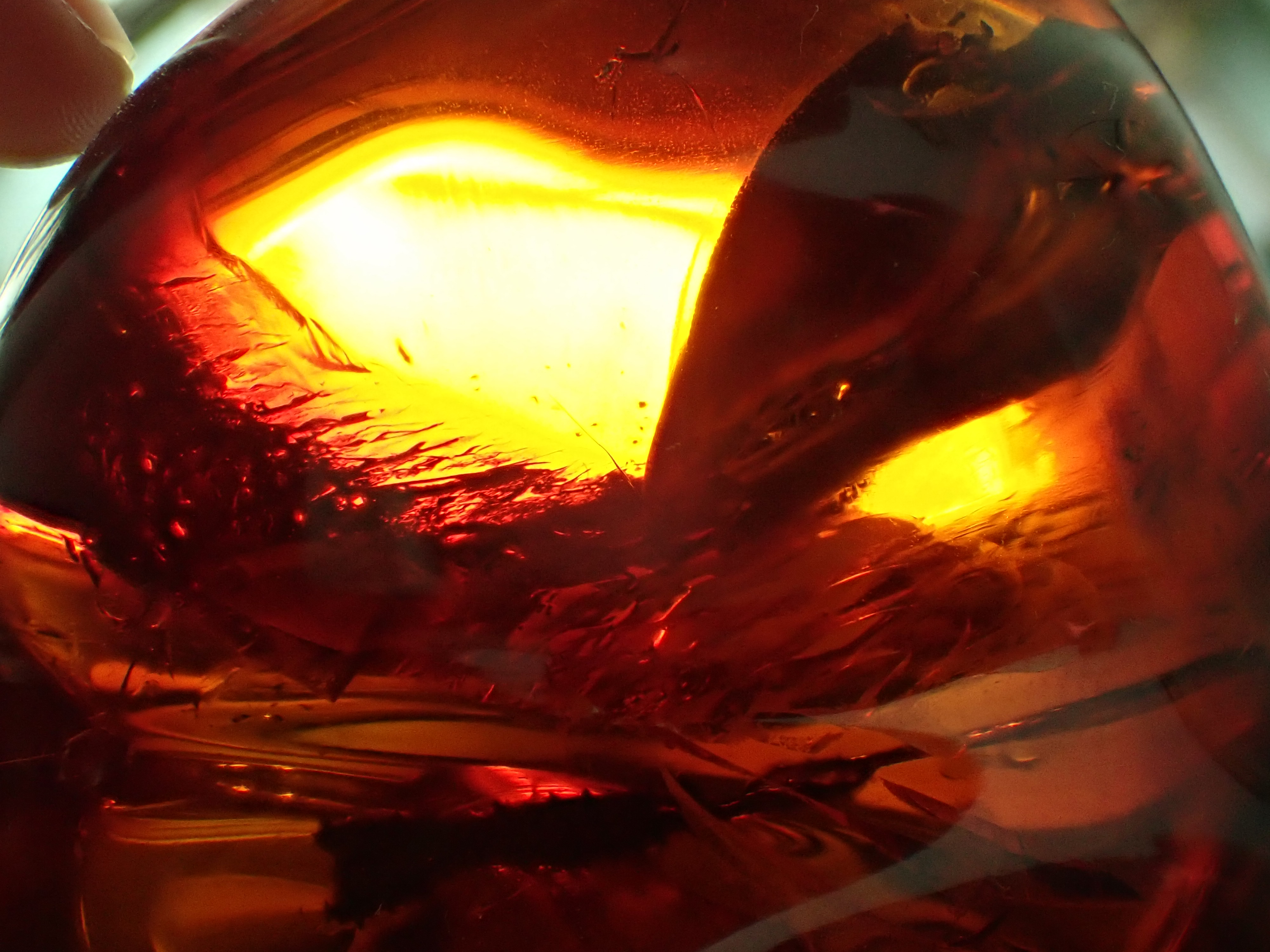
Classic image close up showing the toothed beak of the Archaeopteryx style bird resting on its frontwing that has metallic bright red feathers, note this is the largest most complete Cretaceous bird ever found in amber.
Should you require further bird in amber imagery do not hesitate to contact us. The items displayed are just part of our continually growing collection and should you be seeking a species not shown here just let us know and we will get back to you promptly.
Note that the French auction house Drouot have this piece listed as 'Spécimen d'ambre fossile Burmite contenant un oiseau'
Bid now at Summers Place Auctions website
Bid now at Drouot website
Bid at The Saleroom website
Wherever and however you bid make sure to submit your absentee bids by 1pm London Time on the 23 November 2021. To be sure of winning it is recommended after leaving an absentee bid that you attend the online auction which is broadcast live from 1 pm London Time.
Note also that this is a very genuine once in a lifetime opportunity as the winner of the auction will be a very very lucky person indeed as
many scientists that have seen this piece are totally in awe as it is far more rare and more beautiful than any T-rex or 2D Archeaopteryx fossil
to date and is potentially priceless.
Size Comparison of the Red Bird vs Lida Xing's Birds
1) The Red Bird offered by AAKZ is 72.24 grammes / 361.22 carats with dimensions of 64.00mm x 51.10mm x 35.46mm
2) The piece called Oculudentavis is so small they are shy to give the weight even Wikipedia cannot provide the weight and dimensions for this tiny piece of amber!
3) HPG-15-2 (Hupoge Amber Museum, Tengchong City Amber Association, China) is an incomplete avian right hindlimb with plumage from the left wingtip preserved in amber, measuring 34.8mm x 34.4mm x 8.2mm and weighing 5.51 grammes.
4) The infamous pancake bird amber specimen, DIP-V-15102 measures approximately 68mm x 7mm x 51mm, and weighs 14.99 grammes.
The AAKZ red bird amber thickness is 51mm whilst the pancake bird is just like a wafer at 7mm, the red bird is over 72 grammes whilst the piece studied by Lida Xing and co is just 15 grammes and some pieces as low as 3 grammes.
We think that a simple size comparison shows that the Red Bird is in a league of its own, on top of that the red bird has true original pigment. The red bird is 100% complete and it also includes a second smaller complete bird lying between its legs.
The amount of money wasted on these tiny ambers is very obvious when compared to the massive Red Bird in amber.
Disclaimer and Acknowledgement - without prejudice
The 'Cretaceous birds' in research papers by people like Lida Xing, Jingmai O'Connor, McKellar and Chiappe are questionable studies done on
poorly sourced cheap flat murky pancake specimens with a deliberate use of ambiguous language by the authors.
These scientists are more into the marketing of fossils with Lida Xing claiming in TV interviews that pancake birds in amber are
selling for up to 500,000$. Here at Advanced Amber we normally sell pancake birds in a range of 500$ to 5000$ depending on size and
quality. The large 3D clear specimens are in a league way above anything ever researched so far. This is not the only retraction that
these scientists have made and their dubious work and roadshow marketing of amber fossils has ironically impeded their research.
At AAKZ we do not try to deceive fossil lovers regarding the availability and true quality range of specimens and instead we strive to bring you the very best top quality
Cretaceous birds in amber at very fair prices.
McKellar himself has very limited knowledge of Burmese amber and research methodologies which adds to a number of mistakes and retractions, he even mistook a lizard for a bird that was shamelessly published in top tier journals prompting a lot of animosity in the paleo community, that bird was named Oculudentavis.
Unlike these commercial paleontologists AAKZ does not offer dubious small fragments of flat amber that is difficult to understand, instead of providing a rotting bird corpse in amber we strive to bring you perfectly posed 100% complete specimens in clear amber. We achieve this seemingly impossible goal by painstakingly searching for amber filled tree hollows in fossilized trees 60 meters under the ground. McKellar on the other hand studies small tiny trinkets that have been bought in commercial little gem markets near the Chinese border without putting in the investments of knowledge, time and money made by AAKZ.
At AAKZ we feel that all scientists should have the opportunity to study full and complete fossils of reasonably sized specimens where appropriate, we believe that serious effort is involved in acquiring pristine fossils and they cannot be simply bought in markets like the McKellar and Chiappe pieces and then they have their team leader expecting 5 and 6 digit sums of money for them in Beijing markets bringing anger to many paleontologists who view their behavior as profiteering. It is for these reasons that AAKZ is making available large clean birds with full color feathers at very reasonable prices.
We would like to acknowledge that the release of this piece of verified Hukawng amber is to help correct the misinformation about Kachin amber created by lackadaisical paleontologists and that the release of this piece of amber has already created a massive uproar behind closed doors.
The perfect nature of this fossil has caused many paleontologists to question the Burmite amber that they are researching. Here at AAKZ we have observed numerous scientific studies being published or people attempting but failing to publish cheap questionable pieces of amber that they actually sourced from eBay and not Kachin state as they falsely claim.
Here at AAKZ we do not take any of these shortcuts in our sincere efforts to bring you nothing but truly the very very best available by sending our own British led team to Kachin state to ensure that everyone can have the chance to own and research specimens worthwhile researching or displaying proudly in a National Museum.
A small quirky group of deep time scientists have brought disgrace to the field of paleontology in the eyes of many but we would like to point out that most paleontologists are fabulous people with worthy roles and it is a very small number often refered to as deep time vertebrate paleos essentially meaning paleos obsessed with dinosaurs and pterosaurs and the marketing of books and calendars rather than real science.
To all the angry paleontologists who are busy studying small pancake fragments we are truly sorry, it is not our intention to interfere or belittle your efforts. There is nothing unethical whatsoever with undescribed fossils going on auction, there is also nothing unethical about a fossil being revealed on an auction site before appearing in Nature magazine or even National Geographic.
We all must remember that if we are not on our best behavior it is not easy for Santa Claus to drop a truly glorious piece of amber into
the sock hanging from the end of our beds; so rather than refuse to accept the truth, abandon your Linus Blanket 2d Lithic fossils and 2 and a half dimensional flat pancake ambers and open your hearts and minds to a brave new world of pristine vertebrate volant animals in Cretaceous amber or you too may end up becoming like the dinosaurs.
We are not affiliated with dubious research
Many other vertebrate amber research papers do not mention weight or dimensions or are very vague about these important details which brings into question the peer review process of many vertebrate amber research papers.
McKellar and Chiappe might try to tell you that size does not matter as they show off their thumbnail sized vertebrate animals in amber but those that have seen the Red Bird
know that size might not matter to some people but there are those more educated customers wanting the very best and clearest of sparrow sized birds instead of humming bird size versions all squished and broken beyond recognition.
Indeed there are decent folk like Michael Benton down in Bristol who started research with Lida Xing on the amber but must have realised how questionable the science was so he stopped co-authoring with Lida Xing
and so we only see the remaining O'Connor, Schmitz, Chiappe, McKellar brave enough to put their name on these dubious papers.
Note!!! We are simply displaying a feathered vertebrate and calling it simply a Red Bird, it is what it is and we have no interest in the semantics of the deep time Paleo world we do not wish to call these critters feathered pterosaurs or Enantiornithes or Anurognathids or Archaeopteryx or Troodontidae or Dromaeosauridae or Oviraptorosaurs or Opposite Birds or Urvogel or Avisauridae or Pennaraptora ,
neither are we claiming that this is Adam the first bird in the World or Eve the Original Bird, it is offered simply as a large complete RED BIRD from the time of the DINOSAURS, although we are not claiming that birds are dinosaurs, we are not claiming that they are not dinosaurs either,
that said because it IS a BIRD from the time of the dinosaurs there is no harm in calling it a Dino Bird in our opinion,
if you don't like that name then there are dozens of new names in the market for you choose from and argue about.
Unlike many dubious or fragmentary specimens the immaculate nature of top shelf Cretaceous birds from the AAKZ archives like this exemplary Red Bird offered here is arguably the most perfect specimen of a bird from the Cretaceous, so perfect perhaps that hopefully it will inspire a new generation of paleontologists to study things for what they are rather than squabble and bicker over their names.
This Red Bird is a holotype so the owner will actually have the right to name it themselves and we hope that it is named after its features rather than the modern practice of many dubious deep time vertebrate paleos who have started to name these creatures after pop stars or sometimes naming it after themselves or their friends.
Not only are there are a mass of English, Greek and Latin names there are also Germanic names and Chinese names,
of all the Chinese names we like Yi Qi the most as it means Dino Bird or Bird from the time of the dinosaurs.
When we say Dino Bird we are saying Dino-Era Bird we are not saying it is a Dinosaur we are saying it is a bird from the era of the dinosaurs and thanks to comprehensive dating of amber from Hukawng in Kachin State where Lida Xing takes ambers from 20 meters deep and offers them as pancake birds that are 99 million years old, the RED BIRD was mined at a depth of 60 meters, 40 meters deeper than the pancake bird and so we are confident that it is at least 99 million years old and possibly older.
When asked about Oculadentavis Dr. Jingmai O’Connor said, “It’s just a skull, and there are no features preserved in it that are like ‘this is definitively avian.’” Such statements show how extremely dubious Lida Xing's entire team is. Please also note that Jingmai O'Connor is based in Chicago the same city as Christopher Meehan who makes false claims to be working with our archive on ResearchGate and we would like to state that we are not involved in the research of any sub standard or questionable amber specimens like this team. The odds of finding another Oculudentavis specimen, Dr. O’Connor quipped, are about “.0001 percent, or something.” Note that again O'Connor fails to mention what percentage of what she is talking about, this lazy wonton approach has brought alot of general shame on amber research and we hope to help the field of paleontology repair the damage done by this small roguesque band of paleontologists.
“We were able to show that this skull is even smaller than that of a bee hummingbird, which is the smallest dinosaur of all time — also the smallest bird,” Dr. O’Connor said. “This is a tiny skull, and it’s just preserved absolutely pristinely.” We can see that O'Connor is very naïve and lacks understanding of basic anatomy leading to a nonsense scientific paper passing peer review the being published in peer review papers bringing even greater shame to the field of amber research. These careless false claims made continually by O'Connor and Meehan in Chicago have brought immense damage to the field and also sadly fueled considerable animosity. Some scientists directed their animosity towards AAKZ not understanding that we have nothing to do with the research of these pieces whatsoever. We did assist Christopher Meehan with volant vertebrate samples which he said were for Naomi Campbell's team in Harvard and Peter Makovicky at the Chicago Field museum,
years passed and both Campbell and Makovicky failed to produce any research on these pieces. Note that ironically these high level pieces were supposedly donated to the Chicago Field Museum the same institute that employs O'Connor the woman who produces dubious papers from dubious amber samples with Lida Xing.
We are not sure about the politics involved and why she ignores the top shelf specimens at the Field Museum with Makovicky and focuses instead on her fantasy research of little amber fragments. We would like to make it very clear that we do not work with O'Connor, Meehan, Harvard or the Field Museum, nor are we responsible for them confusing birds with lizards.
Note there were no feathers whatsoever in the Oculadentavis amber of Lida Xing, not even one little broken feather, whilst in the AAKZ archives numerous Cretaceous birds come complete with immaculate plumage that often retain original pigments, we do have heads in amber but often advise that
researchers consider studying complete specimens rather than trying to break one study into a dozen studies just to continually embezzle research grants. Is it worth sponsoring scientists to study featherless fragments of birds when full feathered versions exist? Magazines like Nature and NatGeo publish cheap little fossils whilst better ones litter eBay and far superior versions exist in the archives of professional collectors like AAKZ. Many honest paleontologists spend years perfecting their research but this small posse of paleos led by Lida Xing has behaved like a peer reviewed paper factory churning out masses of tiny little papers based on questionable samples and questionable research. Research shows that paleontologists all over the World are saddened by these money grabbing paleos that publish clickbait style research by glorifying lizards as Dino Birds.
We did not create the low hanging fruit loophole
At AAKZ we simply perform preliminary research and verification before archiving specimens and from time to time some specimens may be sold or donated to science or education. We are not the only providers of Burmite amber there are many giving rise to hoardes of undiscovered flora and fauna can be found on eBay.
This meant that an extinct bug never seen before could be purchased from eBay for a few dollars and then a research grant could be applied for so that taxpayers money could be put to good use. It was like the invention of fire or the ladder, it was not one man who invented it but many in many different places.
This plethora of undiscovered flora and fauna flooding the Internet meant that suddenly there were literally thousands of research papers to be written.
All around the World paleontologists would go home after work and get their friends and family to buy and hoarde unseen
spiders, crabs, birds, bats, lizards, mantises ....the list goes on and on carnivorous plants, pollens, insects eating eachother, insects mating. Normally poor quality amber from Baltic states Canada or Lebanon would be small brittle ambers not the incredible hard tough shiny transparent amber of Myanmar that hosted the largest most mind-boggling variety of flora and fauna.
This high quality amber then sold at prices cheaper than the low quality ambers and younger ambers of Indonesia, Dominican Republic and Chiapas in Mexico creating further chaos in global amber markets. This tsunami of Cretaceous critters gave the rogue paleos a field day as they surfed the web picking up so many new discoveries that suddenly we are seeing a amber research papers being released every few hours instead or every few days.
Suddenly research grants and budgets that were hard to grab became easy, as they say in the research industry "low-hanging fruit".
We support the motion that feeding the public research of fragments or pancakes or rotten carcasses or colorless specimens is misleading the public if full complete pigmented versions are available. Studying a fragment is a much easier and faster way of guzzling research grants and budgets than having to do the honest job of studying the complete creature in its habitat properly.
By using complete specimens like those at AAKZ far less mistakes would be made and magazines like Nature would not look like cheap marketing media, we cannot call a journal top-tier if they cannot tell the difference between a lizard with no feathers and a bird with feathers.
It is for these reasons that we do not offer cheap eBay quality amber of small sizes but source giant tree hollows directly from the mines, this requires considerable work and investment.
Note the editors of Nature or NatGeo do not know the true origins of specimens in articles they publish, at AAKZ we are very well aware of the actual precise co-ordinates where each piece was mined in hundreds of amber research papers, we also notice that peer reviewers often lack knowledge as there are always numerous mistakes that they allow go to print.
It is almost as if people just want to throw money party and print magazines without caring about what is the truth nor about quality.
Paleo Peekers and Peepers
At AAKZ we like to promote rapid scientific growth by using OS solutions and Machine Learning to better identify specimens using nano or micro ct scanning and optical imaging. We happily share new specimens which has caused a small number of dinosaur obsessed paleontologists to become disgruntled. In one instance scientists complained that Michael Benton must have been peeking at AAKZ like many other paleontologists to grab another type of low hanging fruit for free; free imagery equals free knowledge that leads to great inspiration for great discoveries.
They complained that Benton must have seen the pigment on some of our specimens, upon seeing the specimen he had a brainwave, a eureka moment and he remembered the pigment in a lithic Chinese bird fossil and quickly verified it grabbing a lovely study to wipe the smiles off many other paleontologists as he published his study so fast that it left many paleontologists dazed, indeed Benton scored a double whammy when he then spotted that some "pterosaurs" had feathers, this discovery greatly shamed numerous paleontologists and many again suspected that Benton had peeked at some amber images again for inspiration to revisit old lithic fossils and make new discoveries thereby proving that his eyes do see more than the limited competition in the field.
We do not know from where Benton gets his magnificent inspiration from all the time, out webstats show numerous visitors coming to look at amber images from Bristol but we do not know if Benton is yet another one of our secret admirers.
I mean so what there is nothing wrong with admiring images of beautiful 3d fossils, there is nothing wrong with being inspired by numerous fossils before revisiting an old fossil that is near and dear to you. If Michael Benton was inspired then that is an honor and if not then he still published shock cinema without having to buy a single piece of amber.
The real point is what should it matter what inspired Michael Benton to make so many novel discoveries staring everybody in the face but nobody else could see the colors and feathers except Michael Benton and also perhaps David Peters. Deep time vertebrate Paleos should be aware that David Peters also has a website and maybe Benton was peeking there and not at aakz.com. Basically other scientists claim that
they were preparing to publish the same findings as Benton but from Amber fossils and that they were researching. These scientists behind closed doors started crying "Benton has scooped us", no it has nothing to do with ice-cream, scoop is a paleo term meaning to quickly publish a fossil that somebody else is studying before they do thereby being the first and the winner.
The fact that Michael Benton is first again and again frustrates many paleos often oceans away as he scoops away here and he scoops away there being a true winner. Instead of being jealous with winners like Benton and trying to find fault one should simply appreciate the contributions made to science and remember that every dog has its day.
We have no real competition
Dexu Institute of Palaeontology (DIP)is just an example of a little collection of amber made by Lida Xing and his buddies that was made in a bid to copy the AAKZ Scottish Highland Archive which has been archiving amber since Lida Xing was a media journalist.
It is not surprising that magazines like Science use ridiculous ultra hype language to describe little pancake ambers as BLOCKBUSTERS before going on to quote fantasy prices pulled out of thin air to create an illusion that these fossils are worth far more than their actual market price. Science magazine then quotes paleontologist David Grimaldi, curator of the amber collection at the American Museum of Natural History in New York City who grabbed 75 kilos of cheap Burmite from a Canadian dealer as saying "Right now we're in this frenzy, almost an orgy".
The Red Bird on offer here makes the amber collections of Xiao Jia, Xia Fangyuan, Roger Long, Dr Grimaldi, Christopher Meehan, Sam Cooley, Lida Xing, Keith Luzzi and Wang Bo look like cheap trinkets, that said their collections surpass the collections of most national natural history museums on the planet. The fact that our dino bird collection makes the collections around the world look cheap and second rate is not our intention at all, we do not mean to offend but to enlighten the public to the reality that proper high quality fossils also exist in this world and not just the junks that are pimped in Science, Nature and NatGeo by capitalistic collectors.
Bid now at Summers Place Auctions website
Bid now at Drouot website
Bid at The Saleroom website
We support the motion that feeding the public research of fragments or pancakes or rotten carcasses or colorless specimens is misleading the public if full complete pigmented versions are available. Studying a fragment is a much easier and faster way of guzzling research grants and budgets than having to do the honest job of studying the complete creature in its habitat properly. By using complete specimens like those at AAKZ far less mistakes would be made and magazines like Nature would not look like cheap marketing media, we cannot call a journal top-tier if they cannot tell the difference between a lizard with no feathers and a bird with feathers.
It is for these reasons that we do not offer cheap eBay quality amber of small sizes but source giant tree hollows directly from the mines, this requires considerable work and investment.
Note the editors of Nature or NatGeo do not know the true origins of specimens in articles they publish, at AAKZ we are very well aware of the actual precise co-ordinates where each piece was mined in hundreds of amber research papers, we also notice that peer reviewers often lack knowledge as there are always numerous mistakes that they allow go to print. It is almost as if people just want to throw money party and print magazines without caring about what is the truth nor about quality.
They complained that Benton must have seen the pigment on some of our specimens, upon seeing the specimen he had a brainwave, a eureka moment and he remembered the pigment in a lithic Chinese bird fossil and quickly verified it grabbing a lovely study to wipe the smiles off many other paleontologists as he published his study so fast that it left many paleontologists dazed, indeed Benton scored a double whammy when he then spotted that some "pterosaurs" had feathers, this discovery greatly shamed numerous paleontologists and many again suspected that Benton had peeked at some amber images again for inspiration to revisit old lithic fossils and make new discoveries thereby proving that his eyes do see more than the limited competition in the field. We do not know from where Benton gets his magnificent inspiration from all the time, out webstats show numerous visitors coming to look at amber images from Bristol but we do not know if Benton is yet another one of our secret admirers. I mean so what there is nothing wrong with admiring images of beautiful 3d fossils, there is nothing wrong with being inspired by numerous fossils before revisiting an old fossil that is near and dear to you. If Michael Benton was inspired then that is an honor and if not then he still published shock cinema without having to buy a single piece of amber.
The real point is what should it matter what inspired Michael Benton to make so many novel discoveries staring everybody in the face but nobody else could see the colors and feathers except Michael Benton and also perhaps David Peters. Deep time vertebrate Paleos should be aware that David Peters also has a website and maybe Benton was peeking there and not at aakz.com. Basically other scientists claim that they were preparing to publish the same findings as Benton but from Amber fossils and that they were researching. These scientists behind closed doors started crying "Benton has scooped us", no it has nothing to do with ice-cream, scoop is a paleo term meaning to quickly publish a fossil that somebody else is studying before they do thereby being the first and the winner. The fact that Michael Benton is first again and again frustrates many paleos often oceans away as he scoops away here and he scoops away there being a true winner. Instead of being jealous with winners like Benton and trying to find fault one should simply appreciate the contributions made to science and remember that every dog has its day.
The Red Bird on offer here makes the amber collections of Xiao Jia, Xia Fangyuan, Roger Long, Dr Grimaldi, Christopher Meehan, Sam Cooley, Lida Xing, Keith Luzzi and Wang Bo look like cheap trinkets, that said their collections surpass the collections of most national natural history museums on the planet. The fact that our dino bird collection makes the collections around the world look cheap and second rate is not our intention at all, we do not mean to offend but to enlighten the public to the reality that proper high quality fossils also exist in this world and not just the junks that are pimped in Science, Nature and NatGeo by capitalistic collectors.
"If the truth can be told so as to be understood, it WILL be believed."
- Terence Mckenna, paraphrasing William Blake
L'uccello dalle piume di cristallo in ambra



